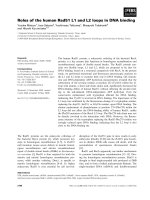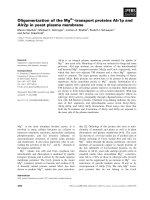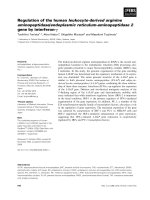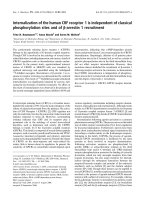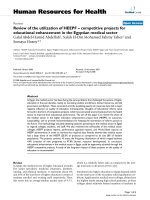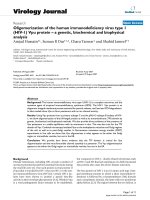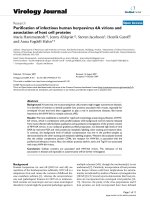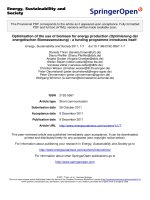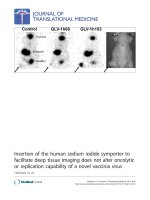Báo cáo sinh học: " Oligomerization of the human immunodeficiency virus type 1 (HIV-1) Vpu protein – a genetic, biochemical and biophysical analysis" ppt
Bạn đang xem bản rút gọn của tài liệu. Xem và tải ngay bản đầy đủ của tài liệu tại đây (1.48 MB, 11 trang )
BioMed Central
Page 1 of 11
(page number not for citation purposes)
Virology Journal
Open Access
Research
Oligomerization of the human immunodeficiency virus type 1
(HIV-1) Vpu protein – a genetic, biochemical and biophysical
analysis
Amjad Hussain
†1
, Suman R Das
†1,2
, Charu Tanwar
1
and Shahid Jameel*
1
Address:
1
Virology Group, International Centre for Genetic Engineering and Biotechnology, New Delhi, India and
2
Laboratory of Viral Diseases,
NIAID, NIH, Bethesda, MD, USA
Email: Amjad Hussain - ; Suman R Das - ; Charu Tanwar - ;
Shahid Jameel* -
* Corresponding author †Equal contributors
Abstract
Background: The human immunodeficiency virus type 1(HIV-1) is a complex retrovirus and the
causative agent of acquired immunodeficiency syndrome (AIDS). The HIV-1 Vpu protein is an
oligomeric integral membrane protein essential for particle release, viral load and CD4 degradation.
In silico models show Vpu to form pentamers with an ion channel activity.
Results: Using Vpu proteins from a primary subtype C and the pNL4-3 subtype B isolates of HIV-
1, we show oligomerization of the full-length protein as well as its transmembrane (TM) domain by
genetic, biochemical and biophysical methods. We also provide direct evidence of the presence of
Vpu pentamers in a stable equilibrium with its monomers in vitro. This was also true for the TM
domain of Vpu. Confocal microscopy localized Vpu to the endoplasmic reticulum and Golgi regions
of the cell, as well as to post-Golgi vesicles. In fluorescence resonance energy transfer (FRET)
experiments in live cells we show that Vpu oligomerizes in what appears to be either the Golgi
region or intracellular vesicles, but not in the ER.
Conclusion: We provide here direct evidence that the TM domain, is critical for Vpu
oligomerization and the most favourable channel assembly is a pentamer. The Vpu oligomerization
appears to be either the Golgi region or intracellular vesicles, but not in the ER.
Background
Primate lentiviruses, including HIV, encode a number of
accessory proteins that perform essential functions during
the viral life cycle [1]. One such protein is viral protein U
(Vpu) that is encoded by HIV-1 but not HIV-2 or the sim-
ian immunodeficiency virus (SIV) [2]. Certain HIV-2 iso-
lates have been shown to possess a partial Vpu-like
activity in their envelope glycoprotein [3,4]. Whether Vpu
is a viral pathogenesis factor remains to be established,
but compared to HIV-1, closely related retroviruses such
as HIV-2 and SIV that lack expression of a fully functional
Vpu protein also cause less severe disease outcomes.
The Vpu protein of HIV-1 is an 81-amino acid type I inte-
gral membrane protein in which a short extracellular N-
terminus is followed by a transmembrane (TM) domain
and a cytoplasmic domain, the latter with two prominent
alpha helices [2,5]. The region between the two helices, is
Published: 29 August 2007
Virology Journal 2007, 4:81 doi:10.1186/1743-422X-4-81
Received: 4 July 2007
Accepted: 29 August 2007
This article is available from: />© 2007 Hussain et al; licensee BioMed Central Ltd.
This is an Open Access article distributed under the terms of the Creative Commons Attribution License ( />),
which permits unrestricted use, distribution, and reproduction in any medium, provided the original work is properly cited.
Virology Journal 2007, 4:81 />Page 2 of 11
(page number not for citation purposes)
highly conserved and contains two serine residues (S52
and S56) that are phosphorylated by cellular casein kinase
II [6]. Two primary functions have been attributed to Vpu
during the HIV-1 replication cycle. These include CD4
downmodulation and enhancement of viral particle
release [7].
Like all retroviruses, HIV-1 also interferes with the expres-
sion of its cellular receptor and uses redundant mecha-
nisms to achieve this [8]. The Vpu protein binds CD4 in
the endoplasmic reticulum (ER) [9], and through its phos-
phoserine residues binds the beta transducin-repeat con-
taining protein (βTrCP) in the cytoplasm [10]. The βTrCP
recruits other proteins such as Skp1, Cul-1 and the Cdc34
E2 ubiquitin ligase [11]. This results in ubiquitination of
CD4, its dislocation from the ER and degradation by the
proteosome [12,13]. The stable association of Vpu with
βTrCP also affects the latter's cellular functions, one of
which is to direct the proteosomal degradation of inhibi-
tor of kappa B (IκB) [14]. This results in inhibition of
NFκB activity and the NFκB-dependent expression of anti-
apoptotic genes of the Bcl-2 family [15]. Vpu also medi-
ates the efficient release of viral particles from HIV-1-
infected cells [16]. Though distinct from its CD4 degrada-
tion function, it is not clear whether Vpu enhances virus
release through modification of the cellular environment
or specific interactions with cellular or viral factors. The
formation of conducting ion channels by Vpu [17] and its
interaction with a novel tetratricopeptide repeat contain-
ing protein [18] favour both possibilities. The TM domain
of Vpu has been shown to be important for enhancement
of virus release [19,20] and pathogenicity [21]. This
domain is also critical for its ion channel activity [13,17].
An earlier study has used chemical cross-linking to show
that Vpu can form oligomers [22]. In silico modeling stud-
ies have predicted the same for the TM domain of Vpu
[23]. The oligomeric nature of Vpu is also likely to affect
its interaction with cellular proteins and therefore its role
in HIV-1 pathogenesis. To better characterize the oli-
gomerization of Vpu and the domains for this, we have
used genetic, biochemical and biophysical methods, and
two divergent Vpu proteins, one from a subtype C primary
isolate and the other from a laboratory-adapted subtype B
isolate of HIV-1. Our results show that Vpu or its TM
domain form pentamers in solution. Using confocal
microscopy and fluorescence resonance energy transfer
experiments we further show that Vpu does not oligomer-
ize in the ER, but does so in the Golgi region or in post-
golgi vesicles.
Results
Cloning and expression of a functional Vpu
We used PCR to clone two vpu genes, one from the HIV-1
Subtype B lab-adapted isolate NL4-3 and the other from a
HIV-1 Subtype C primary isolate from India (called R5).
The translated amino acid sequences (Fig. 1A) showed the
predicted TM domain, the cytoplasmic helices and the
conserved serine residues of the Vpu protein. Multiple
clones of R5 Vpu showed it to be 82 amino acids in length
with two additional amino acids at the N-terminus and a
deletion at residue 67 compared to NL Vpu. On compar-
ing these sequences to those in the Los Alamos HIV data-
base, Subtype C Vpu proteins were found to contain 2–5
extra amino acids at their N-terminus (Fig. 1A). Phyloge-
netic analysis of aligned sequences showed the R5 Vpu
protein to be closest to the consensus sequence subtype C
Vpu proteins in the database (Fig. 1B). Earlier, based on
envelope heteroduplex mobility assay and the 3.5 kb vpr-
env fragment sequence, we had determined the R5 pri-
mary isolate from India to belong to HIV-1 subtype C
(SRD; unpublished). To ensure that the cloned vpu gene
expressed a functional protein, a transfection-based HIV
replication assay was set up. HeLa cells were transfected
with wild type or vpu-deficient proviral DNA, the latter in
the absence or presence of an R5-vpu expression vector.
The virions released in the culture medium and those
present within the cells were quantitated by western blot-
ting with anti-Gag antibodies. As shown in Fig. 1C, while
vpu-deficient proviral DNA produced as much virions as
wild type proviral DNA (lanes 4 and 5), the release of vir-
ions into the culture medium was compromised in the
absence of vpu (lanes 1 and 2). However, this phenotype
was rescued following cotransfection of the vpu-deficient
proviral DNA with the R5-vpu expression vector (lane 3).
The effects were clearly visible at the level pf p55/p41 pre-
cursors as well as the p24 capsid protein. Thus, the R5 Vpu
protein was functional in promoting virus release from
cells.
Homotypic and heterotypic interactions of full-length and
truncated Vpu proteins
To test for the interaction between Vpu monomers, the
full-length and truncated vpu genes were subcloned into
the yeast two-hybrid expression vectors as fusions to the
GAL4 DNA-binding domain (BD) and activation domain
(AD). The expression of the full-length or truncated Vpu
fusion proteins from these constructs was verified by T7
RNA polymerase mediated coupled in vitro transcription-
translation (data not shown). The yeast two-hybrid assays
were performed in S. cerevisiae AH109 cells as described in
Materials and Methods. A representative set of plates is
shown in Fig. 2A. All transformants grew on nonselective
yeast extract-peptone-dextrose (YPD) plates (panel 2).
Single transformants and all cotransformants containing
AD-Vpu grew on SD/L
-
plates (panel 3); similarly, those
containing BD-Vpu grew on SD/T
-
plates (panel 4) and
cotransformants grew on SD/LT
-
plates (panel 5). Cotrans-
formants that contain interacting protein pairs fused to
AD and BD can transactivate the HIS3 gene resulting in
Virology Journal 2007, 4:81 />Page 3 of 11
(page number not for citation purposes)
growth on SD/LTH
-
plates. The growth of AD-Vpu/BD-
Vpu cotransformants on a SD/LTH- plate (panel 6)
showed homodimerization of the Vpu protein. Colonies
were transferred to a nitrocellulose filter and a β-galactos-
idase filter assay was carried out. The presence of β-galac-
tosidase activity only in the positive control and AD-Vpu/
BD-Vpu cotransformants (panel 7) further confirmed the
Vpu-Vpu interaction.
A more extensive screen, whose results are summarized in
Fig. 2B, was carried out as above. Both NL Vpu and R5 Vpu
showed homotypic interactions. Further, the NL Vpu and
R5 Vpu proteins interacted with each other. All these
interactions were found to depend upon the TM domains,
but not on the cytoplasmic domains of Vpu. The trans-
formants were grown in the presence of 20 mM 3-amino-
triazole (3AT) to further confirm the specificity and
strength of the interactions. All cotransformants that grew
on SD/LTH
-
plates also grew on SD/LTH
-
3AT plates. Com-
pared to the positive control (BD/SNF1+AD/SNF4), the
semi-quantitative liquid β-galactosidase assay showed
reasonably strong interactions between the full-length
Vpu proteins and slightly weaker interactions between
their TM domains. The values were higher for homolo-
gous interactions (NL vs NL and R5 vs R5) as opposed to
heterologous interactions (NL vs R5). A variety of negative
controls showed no interaction and only background β-
galactosidase activity.
Cloning and expression of functional VpuFigure 1
Cloning and expression of functional Vpu. (A) An alignment of the NL-Vpu (subtype B) and R5-Vpu (subtype C) protein
sequences is shown. Boxes show sequence conservation; dark shading indicates sequence identity and light shading indicates
conservative changes. The transmembrane domain, cytoplasmic helices and phosphoserine residues (black circles) are indi-
cated. Residues are numbered according to the NL-Vpu sequence. (B) Phylogenetic comparison of the NL and R5 Vpu protein
sequences to the consensus Vpu sequences for different HIV-1 subtypes available in the Los Alamos HIV sequence database
The tree was drawn using the ClustalW
(V1.4) algorithm in MacVector v7.2.2 (Accelrys). A Blosum similarity matrix was used with the following settings: Open Gap
Penalty = 10; Extend Gap Penalty = 0.1; Delay Divergent = 40%; Gap Distance = 8. Numbers indicate the relative distance. (C)
HeLa cells were transfected with wild type (Vpu+) or vpu-deficient (Vpu-) HIV-1 proviral DNA, the latter with empty vector
(lanes 2 and 5) or an R5-Vpu expression vector (lanes 3 and 6), as described in Methods. Virions released in the culture
medium (lanes 1–3) and intracellular virions (lanes 4–6) were estimated by western blotting with anti-p24 antibodies. The
bands corresponding to the HIV-1 capsid precursors p55 and p41, and the mature p24 are indicated.
Virology Journal 2007, 4:81 />Page 4 of 11
(page number not for citation purposes)
Gel electrophoresis and in vitro binding assays
We also tested the oligomerization of full-length Vpu
(NL/R5) as well as its TM and cytoplasmic domains by
polyacrylamide gel electrophoresis. The Vpu proteins
were synthesized from the pGBK-Vpu and pGAD-Vpu
plasmid templates using an in vitro-coupled transcription-
translation assay (TNT; Promega, Madison, USA), in the
presence of
35
S-methionine. When these proteins were
analyzed on native polyacrylamide gels (Fig. 3A), oligo-
meric species were prominently observed for full-length
Vpu and its TM domain, but not for the cytoplasmic
domain. A maltose binding protein (MBP)-Vpu fusion
protein was expressed in E. coli and bound to amylose
resin (New England Biolabs, Beverly, USA). The
35
S-
labeled in vitro synthesized Vpu proteins were then passed
through these beads. Both full-length Vpu and its TM
domain were retained on amylose beads saturated with
MBP-Vpu, but not with the MBP control (Fig. 3B). The
cytoplasmic domain of Vpu did not bind to MBP-Vpu in
this assay. These results further support Vpu oligomeriza-
tion through its TM but not the cytoplasmic domain.
Vpu forms a pentamer in vitro
Gel permeation chromatography of
35
S-labeled full-
length Vpu protein or its TM domain was carried out to
characterize their oligomeric states. The proteins synthe-
sized by in vitro coupled transcription-translation reac-
tions were separated on a pre-calibrated Sephacryl
S200HR column. Two prominent peaks of radioactivity
were eluted for full-length as well as the TM domain pro-
teins (Fig. 4). The faster eluting peak corresponding to the
oligomer typically contained about 10% of the radioactiv-
ity. The peak oligomer and monomer fractions were fur-
ther analyzed by SDS-PAGE to confirm the presence of
Vpu (Fig. 4 inset). Based on their elution profiles, the cal-
culated molecular masses were as follows: full-length Vpu
monomer 15.3 kDa, oligomer 77.6 kDa; TM domain
monomer 10 kDa, oligomer 47.8 kDa. Thus, the in vitro
oligomers most closely represented pentamers for the full-
length and TM domain Vpu proteins. These results also
showed that Vpu monomers and pentamers existed in a
stable equilibrium in vitro in the absence of other cellular
components.
Subcellular localization and FRET analysis
It has been observed that Vpu localizes primarily to the
cytoplasmic endomembrane structures in infected [16] as
well as transfected cells [20]. We tested subcellular locali-
zation of the Vpu protein in transfected COS-1 and U2-OS
cells. The cells were cotransfected with EGFP- or ECFP-vpu
and either DsRed-ER, DsRed-mito or EYFP-Golgi expres-
sion vectors. The confocal images were sequentially
acquired and merged for colocalization. In both cell types,
the Vpu protein colocalized with the ER and Golgi mark-
ers (Fig. 5), but not with the mitochondrial marker (not
Yeast two-hybrid analysisFigure 2
Yeast two-hybrid analysis. (A) Representative plates
showing homotypic interactions of the R5-Vpu protein. The
first panel shows the template for the remaining panels that
in turn show transformants streaked in each section of the
indicated plates. Growth is seen as light streaks on a dark
background, except in the β-galactosidase filter assay where
signal is seen as dark streaks on a light background. (B) Com-
plete results for the entire screen using NL-Vpu and R5-Vpu
full-length, transmembrane domain and cytoplasmic domain
fusions to the Gal4 protein DNA-binding domain (BD) or
activation domain (AD). Growth (+) or no growth (-) of
transformants on various media is shown. LTH-3AT repre-
sents growth on SDLeu
-
Trp
-
His
-
plates containing 20 mM 3-
amino-1,2,3-triazole. The β-galactosidase filter assay results
are indicated as + or - and the liquid β-galactosidase assay
values are shown in parentheses as an average of two inde-
pendent measurements. Various negative and positive con-
trols are also shown.
Virology Journal 2007, 4:81 />Page 5 of 11
(page number not for citation purposes)
shown). While a majority of the Vpu protein was found to
be associated with the ER, significant amounts were also
found to be associated with the Golgi.
To detect intimate protein-protein interactions in vivo, we
used fluorescence resonance energy transfer (FRET). This
non-radiative energy transfer between donor and acceptor
fluorophores is critically dependent upon the distance
and dipole orientations of the two partners, and is taken
as evidence of an interaction between them [24]. We
cotransfected COS-1 or U2-OS cells with vectors express-
ing Vpu proteins fused to the cyan (ECFP) and yellow
(EYFP) colored variants of the enhanced green fluorescent
protein as the donor-acceptor FRET pair [25]. To measure
FRET in cells, we followed an acceptor photobleach proto-
col wherein the mean fluorescence intensities from the
donor (ECFP) and acceptor (EYFP) fluorophores were
recorded before and after EYFP photobleaching. Two pat-
terns of Vpu expression were observed in transfected COS-
1 cells. In cells expressing low levels of the protein, a punc-
tate and vesicular distribution was noted (Fig. 6; upper
panels). However, cells expressing high levels of Vpu were
found to accumulate this protein in intensely staining
subcellular structures present on one side of the nucleus
(Fig. 6; middle panels); these structures were also marked
with the transfected DsRed-ER marker (not shown). Addi-
tionally, Vpu was also detected in more distal vesicular
structures. In U2-OS cells, Vpu was similarly distributed in
the ER, Golgi and punctate vesicular structures (Fig. 6;
lower panels).
We carried out FRET measurements in live cells showing
various patterns of Vpu subcellular distribution. Two dif-
ferent areas within the same cell, one showing colocaliza-
tion and another where no colocalization was observed
were subjected to FRET analysis. As expected (and seen in
the merged image), the Vpu-ECFP and Vpu-EYFP proteins
colocalized in transfected cells (Fig. 6; upper panels). On
simultaneous scanning of the two fluorophores, there was
an increase in cyan (donor) fluorescence following
Vpu oligomerization based on gel electrophoretic and pull-down assaysFigure 3
Vpu oligomerization based on gel electrophoretic and pull-down assays. The full-length R5-Vpu protein and its trans-
membrane and cytoplasmic domains were synthesized and labeled with
35
S-methionine in a coupled in vitro transcription-trans-
lation system. (A) The proteins were analyzed on native polyacrylamide gels without heating or DTT treatment. Lanes 1,3 and
5, markers; lanes 2,4 and 6, Vpu full-length, TM domain and cytoplasmic domain, respectively. The molecular sizes (in kilodal-
tons) are indicated. (B) For pull-down assays, the
35
S-labeled R5-Vpu proteins were synthesized in vitro and bound to amylose
beads saturated with either the maltose binding protein (MBP)/R5-Vpu fusion protein or MBP alone as a control. The beads
were washed, resuspended in loading dye buffer, boiled and the supernatants subjected to SDS-PAGE. The gels were dried and
autoradiographed. Gels show the full-length (FL) R5-Vpu protein, or its transmembrane (TM) or cytoplasmic (cyto) domains,
retained on the beads. Arrows indicate the full-length or truncated Vpu proteins.
Virology Journal 2007, 4:81 />Page 6 of 11
(page number not for citation purposes)
bleaching of the yellow (acceptor) fluorophore. Multiple
FRET measurements were carried out in more than one
region of the same cell with similar results (not shown).
In COS-1 cells showing this pattern of Vpu distribution,
the mean fluorescence intensities of ECFP-Vpu before and
after EYFP-Vpu photobleaching were 111.95 ± 5.7 and
137.30 ± 6.2, respectively. This gave an average FRET effi-
ciency of 18.5%. On the other hand, no FRET was
observed in the ER region in COS-1 cells expressing high
levels of tagged Vpu proteins (Fig. 6; middle panels). In
U2-OS cells, the FRET analysis was carried out in two sep-
arate regions of the same transfected cells (Fig. 6; lower
panels). No FRET was measured in the intensely staining
ER region (Fig. 6, set A). However, FRET between ECFP-
Vpu and EYFP-Vpu was observed reproducibly in regions
of the cell that appeared to be either Golgi or unidentified
vesicles (Fig. 6, set B). The mean fluorescence intensities
of ECFP-Vpu before and after EYFP-Vpu photobleaching
were 70.29 ± 4.26 and 95.04 ± 4.8, respectively. This gave
an average FRET efficiency of 26%. For technical limita-
tions in the imaging, it was not possible to also cotransfect
these cells with subcellular markers to positively identify,
in the same cell, those subcellular structures that support
Vpu-Vpu FRET and those that do not. Overall, our FRET
experiments provide strong in vivo evidence of Vpu-Vpu
interaction in a live cell. Further, based on these results,
Vpu appears to form oligomers in distinct subcellular
locations, primarily in the Golgi and vesicular regions but
not in the ER.
Discussion
Lentiviruses encode a number of unique accessory pro-
teins that are important for viral replication and patho-
genesis, but are not encoded by other retroviruses. The
versatility of HIV accessory proteins arise from their abil-
ity to function as adaptor molecules that connect various
viral and cellular proteins to pre-existing cellular path-
ways, modulate these pathways and control processes
important for viral replication. Thus, protein-protein
interactions are an important aspect of the functioning of
these proteins. The Vpu protein of HIV-1 is known to bind
CD4 and βTRCP, the latter being a component of the E3
ubiquitin ligase complex. This association is instrumental
in dislocation of CD4 from the ER, its ubiquitination and
subsequent degradation by the proteosome [10]. The
other function of Vpu is to promote the release of progeny
viruses from infected cells. This appears to be dependent
upon the ability of Vpu to form oligomeric complexes
with an ion channel activity in cellular membranes [7].
The nature of the Vpu oligomer is important due to its
functional significance in virion release. An earlier study
used chemical cross-linking to demonstrate the oligomer-
ization of Vpu [22]. Here we have used various genetic,
biochemical and biophysical approaches to characterize
the oligomerization of Vpu in vitro and in vivo. Molecular
dynamic simulations and conductance studies have
shown that the Vpu TM domain is sufficient for its ion
channel activity [26] and the pattern of channel activity is
characteristic of the self-assembly of conductive oligomers
Gel permeation analysis of Vpu oligomersFigure 4
Gel permeation analysis of Vpu oligomers. In vitro translated and
35
S-labeled Vpu proteins were separated by gel perme-
ation chromatography as described in Methods. The eluted
35
S counts in each fraction are indicated for the full-length (black
circles) or TM domain (black squares) Vpu proteins. The positions of Vpu monomers and oligomers are indicated. The inset
shows SDS-PAGE analysis of the peak fractions. Lanes: 1, Vpu oligomer; 2, Vpu monomer; 3, TM domain oligomer; 4, TM
domain monomer; lane M shows molecular size marker as indicated (in kilodaltons).
Virology Journal 2007, 4:81 />Page 7 of 11
(page number not for citation purposes)
in the membrane [27]. This suggested that the TM domain
of Vpu would also be required for its oligomerization. We
provide here direct evidence that the hydrophobic N-ter-
minal TM domain, and not the charged cytoplasmic
domain, is critical for Vpu oligomerization. The two-
hybrid and MBP pull-down analyses further showed that
full-length Vpu proteins as well as their TM domains
derived from two different HIV-1 subtypes interacted effi-
ciently with each other. The isolated TM domains also
showed stable interaction with the full-length Vpu pro-
tein. Molecular-dynamic simulations of ion channels
formed by the Vpu TM domain predict the most favoura-
ble channel assembly to be a pentamer, but higher and
lower oligomeric species were also predicted [23,28].
Recently, Becker et al [29] have used synthetic proteins
containing a carrier template to which four or five pep-
tides corresponding to the Vpu TM domain were attached,
to demonstrate ion channel formation by oligomeriza-
tion of the TM domain. In our analysis, multimeric spe-
cies, including pentamers were evident on gel
electrophoresis of the in vitro synthesized Vpu proteins
and their TM domains. Further, molecular sizing of in vitro
synthesized Vpu by gel permeation chromatography
clearly showed it to assemble into a pentameric species.
Thus, while complementing earlier studies [23,28,29] we
provide direct evidence for pentamerization of the full-
length Vpu protein as well as its TM domain. In vitro syn-
thesized Vpu proteins, in the absence of other cellular
components, demonstrated a stable equilibrium between
monomers and pentamers. This demonstrates the inher-
ent ability of Vpu to oligomerize and pentamers appear to
be the thermodynamically most stable form of these oli-
gomers.
Earlier studies have shown Vpu to be localized to the peri-
nuclear region of the cell that includes the ER and Golgi
[16,20]. Using CD4-Vpu fusion proteins and endoglycosi-
dase H resistance, an earlier study has provided evidence
for Vpu movement beyond the ER [30]. A similar fusion
protein was also used to tease out the apoptotic pathway
[15]. Recently, the imaging of a Vpu-EGFP fusion protein
has also localized it to the ER, Golgi and plasma mem-
brane [31]. So, there is evidence that Vpu has the ability to
be transported to post-ER membranes. Several models
have been proposed for a role of the Vpu channel in the
budding of new virions [27]. It has been suggested that
oligomerization of Vpu at the ER could form conducting
channels leading to a collapse in the membrane potential
across the ER cisternae and acceleration of membrane
fusion and protein traffic in the exocytic pathway. Alterna-
tively, at the ER/mitochondrial junctions, Vpu is proposed
to collapse of the mitochondrial membrane potential and
promote apoptosis. It is also possible that Vpu channels in
the plasma membrane may attenuate the cell resting
potential, promoting the fusion and release of new viri-
ons. We have used confocal microscopy and FRET analysis
to test these models. Using transfected fluorescent pro-
tein-tagged Vpu fusion proteins and subcellular markers
we show that Vpu localizes to the ER and Golgi regions
but not to the mitochondria. In the absence of its mito-
chondrial localization, it would be difficult to support a
direct effect of Vpu on the mitochondrial pore transition
complex or transmembrane potential [32]. One possibil-
ity is the effect of Vpu channels on Ca
2+
release from its
intracellular stores in the ER [33]. The FRET analysis in
this study showed no oligomerization of Vpu associated
with the ER, arguing against the role of ER directly or indi-
rectly in this process.
Oligomerization of Vpu was observed by FRET in struc-
tures that were distal to the ER. While these structures
could not be identified positively in the same cell due to
the technical limitations, separate stainings in two differ-
ent cell types (COS-1 and U2-OS) suggested that these
structures might either be Golgi or vesicles associated with
exocytic protein transport. The Vpu ion channel activity
would be detrimental to ER function, inducing ER toxic-
ity, stress and apoptosis of the infected cell. This would go
against the plan of survival of productively infected cells
followed by retroviruses and so nicely exemplified by HIV
Subcellular localization of VpuFigure 5
Subcellular localization of Vpu. U2-OS cells were
cotransfected as described in Methods. The individual and
merged images are shown. In the merged image, magenta and
white arrows indicate Vpu/ER and Vpu/Golgi colocalizations,
respectively.
Virology Journal 2007, 4:81 />Page 8 of 11
(page number not for citation purposes)
[34]. It would therefore make sense for Vpu oligomeriza-
tion to occur downstream of the ER, enroute to the plasma
membrane. Our FRET analysis in live cells supports this
model. Since the cytoplasmic and not the transmembrane
domain of Vpu is required for CD4 relocation from the ER
and its subsequent degradation [20], this scheme would
not affect the CD4 downmodulation function of Vpu.
However, contrasting results have recently been presented
wherein Vpu with a scrambled transmembrane domain
was unable to downmodulate CD4 from the surface of
transfected cells [21]. Whether this is due to the inability
of mutant Vpu to oligomerize, or due to an altered protein
structure or its arrangement in the membrane, remains to
be seen.
Conclusion
We have used genetic, biochemical and biophysical meth-
ods to complement earlier studies on Vpu oligomeriza-
tion and the role of its N-terminal transmembrane
domain in this oligomerization. While theoretical mode-
ling studies [23,28] and synthetic peptides [29] had earlier
predicted pentameric Vpu channels, we provide here
direct evidence for the existence of a Vpu pentamer in sta-
ble equilibrium with its monomer. This was also true for
the Vpu transmembrane domain. Finally, subcellular
localization and FRET analysis argue against an earlier
model of Vpu-mediated virion release based on channel
formation in the ER. Besides channel formation and its
effect on virion release, oligomerization would also influ-
ence the ability of Vpu to interact with host cell proteins
towards regulating the intracellular environment for effi-
cient viral replication, assembly and release. We are cur-
rently targeting this aspect of Vpu biology by screening for
novel cellular partners.
Methods
Cloning and expression of vpu
The vpu gene was PCR amplified with Pfu polymerase
(Stratagene, La Jolla, USA) using as template either the
pNL4-3 plasmid DNA (NIH AIDS Research and Reference
Reagent Program) or a 3.5 kb fragment encompassing the
vpr to env region previously amplified and cloned from a
primary isolate of HIV-1 subtype C (SRD, unpublished).
The PCR primers used were as follows (with the restriction
FRET analysis of Vpu interactionsFigure 6
FRET analysis of Vpu interactions. COS-1 and U2-OS cells were cotransfected with Vpu-ECFP and Vpu-EYFP expression
vectors and FRET was performed as described in Methods. Representative images for COS-1 and U2-OS cells are shown
together with a kinetic profile of the FRET experiment. For U2-OS cells, sets A and B represent the same cell, with FRET car-
ried out in two different regions of colocalization indicated by the box marked 1; the box marked 2 represents a control region
of the cell. A total of 4 independent FRET experiments were carried out in 7–10 different cotransfected cells each time.
Virology Journal 2007, 4:81 />Page 9 of 11
(page number not for citation purposes)
sites in italics): For the NL4-3 vpu gene, Vpu-NL-F,
GGATCCATGCAACCTATAATAGTA GCAATA and Vpu-
NL-R, GAATTCACTACAGATCATCAATATCCCAAG; for
the R5 vpu gene, Vpu-R5-F, GGATCCATGTTAAATTTA-
GATTATAAATTAGGAGTA GG and Vpu-R5-R, GAAT-
TCATTACAAATCATTAACATCCAAAAGCC. The amplified
fragments designated as NL vpu and R5 vpu respectively,
were cloned in plasmid pGEMT-Easy (Promega, Madison,
USA) and sequenced in both directions. The gene frag-
ments corresponding to the transmembrane (TM)
domains were assembled from the following synthetic oli-
gonucleotides: For the NL4-3 vpu TM region, NL-TM-F,
CATGGAGATGCAACCTATAATAGTAGCAATAGTAG-
CATT AGTAGTAGCAATAATAATAGCAATAGCTGTGT-
GGTCCATAGTAATCATAGAATAGG and NL-TM-R,
AATTCCTATTCTATGATTACTATGGACCACACAGCTATT
GCTATTATTATTGCTACTACTAATGCTACTATTGCTAC-
TATTATAGGTTGCATCTC; for the R5 vpu TM region, R5-
TM-F,
CATGGAGATGTTAAATTTAGATTATAAATTAGGAGTAGG
AGCATTGATAGTAGCACTAATCATAGCAATAGTCGTGT-
GGACCATAGTATATATAGAATAGG and R5-TM-R, AATT
CCTATTCTATATATACTATGGTCCACACGACTATT-
GCTATGATTAGTGCTA CTATCAATGCTCCTACTC-
CTAATTTATAATCTAAATTTAACATCTC. The cytoplasmic
domains were PCR amplified using specific primers for
NL vpu and R5 vpu as follows: for the NL vpu cytoplasmic
region, NL-Cyto-F, CCATGGAGTATAGGAAAATATTAAGA
and Vpu-NL-R (shown above); for the R5 vpu cytoplasmic
region, R5-Cyto-F, CCATGGAGTATAGGAAATTGGTA-
CAAC and Vpu-R5-R (shown above).
Vpu functional assay
Eighteen to 24 hr prior to transfection, 0.3 × 10
6
HeLa
cells were plated per 60 mm dish. These were cotrans-
fected with 2 µg of either wild type or vpu-deficient HIV-1
proviral DNA and 0.5 µg of the expression vector pEGFP/
R5-Vpu using Lipofectin (Clontech). As a control, the
empty vector pEGFP-N1 was used. Twenty-four hr post-
transfection, the released virions in the culture medium
were pelleted through a 20% sucrose cushion for 2 hr at
100,000 × g in a Beckman SW41 rotor. The pelleted viri-
ons and harvested cells were lysed in Laemmli sample
buffer. Proteins were separated by electrophoresis on SDS-
10% polyacrylamide gels and western blotted with an
anti-p24 antibody.
Yeast two-hybrid assays
The GAL4-based two-hybrid system contained the DNA
binding domain vector pGBKT7 and the activation
domain vector pGADT7. The NL and R5 vpu genes were
cloned into the pGBKT7 and pGADT7 vectors as EcoRI-
BamHI fragments from the pGEMT-Easy clones. The
nucleotide sequences corresponding to the TM and cyto-
plasmic domains of the Vpu proteins were similarly
cloned in the two-hybrid vectors as NcoI-BamHI frag-
ments, respectively. Expression of the relevant fusion pro-
teins from each of the Vpu two-hybrid constructs was
checked in a T7 polymerase based in vitro coupled tran-
scription-translation system (Promega, Madison, USA)
followed by immunoprecipitation with anti-Vpu antibod-
ies. The yeast two-hybrid analysis was essentially carried
out as described earlier [35,36]. Plasmids pGBKT7-vpu
(BD/NL or BD/R5) and pGADT7-vpu (AD/NL or AD/R5)
plasmids were cotransfected into Saccharomyces cerevisiae
strain AH109 (MATa trp1-901 his3 leu2-3, 112 ura3-52
ade2 gal4 gal80URA3::GAL-lacZ LYS2::GAL-HIS3) contain-
ing the HIS3 and lacZ reporter genes under the control of
GAL4-binding sites. The host strain containing plasmids
pAS2-SNF1 and pACT2-SNF4 was used as a positive con-
trol [37]. Various negative controls that included single or
dual transformants were also run in the same assay. The
AH109 yeast cells were transformed using the lithium ace-
tate procedure and plated on either complete YPD
medium or synthetic dextrose (SD) in the absence of
either leucine (SD/L-) or tryptophan (SD/T-), or both
(SD/LT-). Protein interaction was tested by growth on SD
plates without leucine, tryptophan and histidine (SD/
LTH-) and the specificity of the interaction was tested as
growth on SD/LTH- plates containing 20 mM 3-amino-1,
2, 3-triazole (SD/LTH-3AT). The β-galactosidase filter-lift
assay was carried out as described earlier [35,36]. A semi-
quantitative liquid β-galactosidase assay was carried out
using the substrate chlorophenol red-β-D-galactopyran-
osidase as described elsewhere [38].
In vitro expression and analysis
The in vitro expression of full-length Vpu or its TM or cyto-
plasmic domains was carried out using a coupled tran-
scription-translation system (TNT; Promega, Madison,
USA) as recommended by the supplier. The proteins were
labeled with
35
S-methionine in the same reaction and
their authenticity was checked by immunoprecipitation
with anti-Vpu antibodies. Five µl of the in vitro expression
mix was analyzed by electrophoresis on 12% native poly-
acrylamide gels.
Pull-down assays
The vpu gene was cloned as a BamHI-EcoRI fragment into
the pMal-c2 vector (New England Biolabs, Beverly, USA)
and the maltose-binding protein-Vpu fusion (MBP-Vpu)
protein was expressed in BL21(DE3) cells. Following
induction of a freshly diluted overnight culture with 1
mM IPTG for 4 hr at 37°C, the cells were harvested and
resuspended in PBS containing 0.1% Triton-X100, 10 µg/
ml lysozyme and 1 mM PMSF, and subjected to 5 cycles
each of freeze-thaw and sonication. The sample was cen-
trifuged at 12,000 rpm at 4°C in a microfuge (Biofuge
17RS, Heraeus). To the clarified lysate, amylose resin
(New England Biolabs, Beverly, USA) was added and the
Virology Journal 2007, 4:81 />Page 10 of 11
(page number not for citation purposes)
MBP-Vpu protein was allowed to bind for 2 hr at 4°C. The
resin was washed with 10 volumes of wash buffer contain-
ing 20 mM Tris-HCl, pH 7.4, 0.2 M NaCl, 10 mM β-mer-
captoethanol, 1 mM EDTA to remove non-specifically
bound proteins. To 50 µl of amylose beads saturated with
either MBP or MBP-Vpu, 25 µl of
35
S-labeled Vpu (pre-
pared using a coupled in vitro transcription-translation
system) diluted in 500 µl PBS was added and allowed to
bind for 3 hr at 4°C with end-over mixing. The beads were
then centrifuged down and washed five times with 500 µl
each of PBS containing 0.1% Triton X-100, resuspended
in SDS dye loading buffer and subjected to SDS-PAGE and
fluorography.
Gel permeation chromatography
The oligomeric forms of Vpu were also analyzed by gel
permeation chromatography on Sephacryl S200HR
(Pharmacia-Amersham). Following in vitro expression
and
35
S labeling, 50 µl of the reaction mixture was loaded
on a 36 ml column pre-equilibrated in PBS. The column
was run at a flow rate of 0.4 ml/min and 0.25 ml fractions
were collected. The elution of Vpu was estimated by liquid
scintillation counting and SDS-PAGE analysis of the peak
radiolabeled fractions. For molecular size estimations, the
column was calibrated with lysozyme and BSA under the
same run conditions.
Confocal microscopy and FRET assays
For confocal microscopy and FRET, the NL and R5 vpu
genes were cloned as EcoRI-BamHI fragments in the Living
Colors™ vectors pEGFP-N3, pEYFP-N1 and pECFP-N1
(Clontech). Prior to this, the genes were first PCR ampli-
fied, cloned in the pGEMT-Easy vector and sequenced.
The following PCR primers (with restriction sites shown
in italics) were used: for NL vpu, NL-X-F, GAATTCAT-
GCAACCTATAATAGTAGCAATA and NL-R-GFP, GGATC-
CGCG CAGATCATCAATATCC; for R5 vpu, R5-X-F,
GAATTCATGTTAAATTTAG ATTATAAATTAGGAGTAGG
and R5-R-GFP, GGATCCTGCCAAATCATT AACATC-
CAAAA. For colocalization experiments, COS-1 and U2-
OS cells were seeded at about 50% confluency on cover-
slips in 12-well plates, grown for 18 hr, and then cotrans-
fected with Living Colors™ vectors expressing Vpu and any
of the subcellular markers. At 24 to 48 hr post-transfec-
tion, the PBS-washed cells were fixed with 2% paraformal-
dehyde in PBS at room temperature for 10 min. These
were then mounted using Antifade (Bio-Rad, Hercules,
USA) and sealed. Confocal images were collected sequen-
tially using a 60 planapo NA 1.4 objective on a Radiance
2100 laser scanning system (Bio-Rad, Hercules, USA)
equipped with a Nikon Eclipse TE2000-U microscope. For
FRET analysis, COS-1 and U2-OS cells were similarly
transfected with ECFP-vpu and EYFP-vpu expression plas-
mids. The ECFP-Vpu (FRET donor) and EYFP-Vpu (FRET
acceptor) images were acquired sequentially in live cells
using the Blue diode 405 nm and the Argon ion 514 nm
laser lines, respectively. Images of the ECFP emission were
collected using a 500 DCLPXR dichroic mirror with an
HQ 485/30 emission filter. The EYFP emission images
were collected using a 560 DCLPXR dichroic mirror with
an HQ 545/40 emission filter. FRET was detected using
the acceptor photobleaching approach. Two different
regions within a cell expressing both proteins were
selected as the region of interest (ROI), one for FRET and
the other as a control. The ROI was zoomed in and
bleached with the high intensity Argon 514 laser. The
mean intensities of ECFP and EYFP were simultaneously
recorded in the pre-bleach and post-bleach periods as a
live graph. An increase in ECFP intensity following EYFP
bleaching is indicative of FRET between the donor and
acceptor fluorophores. The percent FRET efficiency was
calculated using the formula
Competing interests
The author(s) declare that they have no competing inter-
ests.
Authors' contributions
AH, SRD and SJ conceived of the study. SRD made the
clones and carried out the Vpu functional assay. AH car-
ried out the yeast two-hybrid and biochemical assays. CT
carried out the confocal microscopy and FRET assays. AH
and SJ wrote the paper. All authors read and approved the
final manuscript.
Acknowledgements
We thank Dr. H. Gottlinger, University of Massachusetts Medical School
(USA) for the HIV-1 proviral DNA constructs and Dr. S. Mahalingam, Cen-
tre for DNA Fingerprinting and Diagnostics (India) for the p24 antibody.
We also thank Dr. Malcolm Martin for pNL4-3, obtained through the NIH
AIDS Research and Reference Reagent Program. This work was supported
by a grant from the Department of Biotechnology, Government of India to
SJ. The University Grants Commission and the Council of Scientific and
Industrial Research, Government of India provided Research Fellowships to
AH and SRD, respectively. An International Senior Research Fellowship of
the Wellcome Trust (UK) to SJ funded the Confocal Microscopy Facility at
ICGEB.
References
1. Freed EO, Martin MA: HIVs and their replication. In Field's Virol-
ogy Volume 2. 4th edition. Edited by: Knipe DM, Howley PM. Philadel-
phia, Lippincott Williams and Wilkins; 2001:1971-2041.
2. Strebel K, Klimkait T, Martin MA: A novel gene of HIV-1, vpu, and
its 16-kilodalton product. Science 1988, 241:1221-1223.
3. Bour S, Strebel K: The human immunodeficiency virus (HIV)
type 2 envelope protein is a functional complement to HIV
type 1Vpu that enhances particle release of heterologous
retroviruses. J Virol 1996, 70:8285-8300.
4. Ritter GD, Yamshchikov G, Cohen SJ, Mulligan MJ: Human immu-
nodeficiency virus type 2 glycoprotein enhancement of par-
ticle budding: role of the cytoplasmic domain. J Virol 1996,
70:2669-2673.
% FRET efficiency
ECFP intensity before photobleach
EC
=−1
()
(
FFP intensity after photobleach)
×100
Virology Journal 2007, 4:81 />Page 11 of 11
(page number not for citation purposes)
5. Cohen EA, Terwilliger EF, Sodroski JG, Haseltine WA: Identifica-
tion of a protein encoded by the vpu gene of HIV-1. Nature
1988, 334:532-534.
6. Schubert U, Henklein P, Boldyreff B, Wingender E, Strebel K, Porst-
mann T: The human immunodeficiency virus type 1 encoded
Vpu protein is phosphorylated by casein kinase-2 (CK-2) at
positions Ser52 and Ser56 within a predicted alpha-helix-
turn-alpha-helix motif. J Mol Biol 1994, 236:16-25.
7. Bour S, Strebel K: The HIV-1 Vpu protein: a multifunctional
enhancer of viral particle release. Microbes Infection 2003,
5:1029-1039.
8. Bour S, Geleziunas R, Wainberg MA: The human immunodefi-
ciency virus type 1 (HIV-1) CD4 receptor and its central role
in the promotion of HIV-1 infection. Microbiol Rev 1995,
59:63-93.
9. Bour S, Schubert U, Strebel K: The human immunodeficiency
virus type 1 Vpu protein specifically binds to the cytoplasmic
domain of CD4: implications for the mechanism of degrada-
tion. J Virol 1995, 69:1510-1520.
10. Margottin F, Bour SP, Durand H, Selig L, Benichou S, Richard V, Tho-
mas D, Strebel K: A novel human WD protein, h-beta TrCp,
that interacts with HIV-1 Vpu connects CD4 to the ER deg-
radation pathway through an F-box motif. Mol Cell 1998,
1:565-574.
11. Bai C, Sen P, Hofmann K, Ma L, Goebl M, Harper JW, Elledge SW:
SKP1 connects cell cycle regulators to the ubiquitin proteol-
ysis machinery through a novel motif, the F-box. Cell 1996,
86:263-274.
12. Fujita K, Omura S, Silver J: Rapid degradation of CD4 in cells
expressing human immunodeficiency virus type 1 Env and
Vpu is blocked by proteasome inhibitors. J Gen Virol 1997,
78:619-625.
13. Schubert U, Anton LC, Bacik I, Cox JH, Bour S, Bennink JR, Orlowski
M, Strebel K, Yewdell JW: CD4 glycoprotein degradation
induced by human immunodeficiency virus type 1 Vpu pro-
tein requires the function of proteasomes and the ubiquitin-
conjugating pathway. J Virol 1998, 72:2280-2288.
14. Bour S, Perrin C, Akari H, Strebel K: The human immunodefi-
ciency virus type 1 Vpu protein inhibits NF-kappa B activa-
tion by interfering with beta TrCP-mediated degradation of
Ikappa B. J Biol Chem 2001, 276:15920-15928.
15. Akari H, Bour S, Kao S, Adachi A, Strebel K: The human immun-
odeficiency virus type 1 accessory protein Vpu induces apop-
tosis by suppressing the nuclear factor kappa B-dependent
expression of antiapoptotic factors. J Exp Med 2001,
194:1299-1311.
16. Klimkait T, Strebel K, Hoggan MD, Martin MA, Orenstein JM: The
human immunodeficiency virus type 1-specific protein vpu is
required for efficient virus maturation and release. J Virol
1990, 64:621-629.
17. Ewart GD, Sutherland T, Gage PW, Cox GB: The Vpu protein of
human immunodeficiency virus type 1 forms cation-selec-
tive ion channels. J Virol 1996, 70:7108-7115.
18. Callahan MA, Handley MA, Lee YH, Talbot KJ, Harper JW, Panganiban
AT: Functional interaction of human immunodeficiency virus
type 1Vpu and Gag with a novel member of the tetratr-
icopeptide repeat protein family. J Virol 1998, 72:5189-5197.
19. Paul M, Mazumder S, Raja N, Jabbar MA: Mutational analysis of the
human immunodeficiency virus type 1 Vpu transmembrane
domain that promotes the enhanced release of virus-like
particles from the plasma membrane of mammalian cells. J
Virol 1998, 72:1270-1279.
20. Schubert U, Bour S, Ferrer-Montiel AV, Montal M, Maldarelli F,
Strebel K: The two biological activities of human immunode-
ficiency virus type 1 Vpu protein involve two separable struc-
tural domains. J Virol 1996, 70:809-819.
21. Hout DR, Gomez ML, Pacyniak E, Gomez LM, Inbody SH, Mulcahy ER,
Culley N, Pinson DM, Powers MF, Wong SW, Stephens EB: Scram-
bling of the amino acids within the transmembrane domain
of Vpu results in a simian-human immunodeficiency virus
(SHIVTM) that is less pathogenic for pig-tailed macaques.
Virology 2005, 339:56-69.
22. Maldarelli F, Chen MY, Willey RL, Strebel K: Human immunodefi-
ciency virus type 1 Vpu protein is an oligomeric type I inte-
gral membrane protein. J Virol 1993, 67:5056-5061.
23. Moore PB, Zhong Q, Husslein T, Klein ML: Simulation of the HIV-
1 Vpu transmembrane domain as a pentameric bundle. FEBS
Lett 1998, 431:143-148.
24. Xia Z, Liu Y: Reliable and Global Measurement of fluorescence
resonance energy transfer using fluorescence microscopes.
Biophys J 2001, 81:2395-2402.
25. Siegel RM, Chan FK-M, Zacharias DA, Swofford R, Holmes KL, Tsien
RY, Leonardo MJ: Measurement of molecular interactions in
living cells by fluorescence resonance energy transfer
between variants of the green fluorescent protein. Sci STKE
2000, 38:pl1. [DOI: 10.1126/stke.2000.38.pl1].
26. Schubert U, Ferrer-Montiel AV, Oblatt-Montal M, Henklein P, Strebel
K, Montal M: Identification of an ion channel activity of the
Vpu transmembrane domain and its involvement in the reg-
ulation of virus release from HIV-1-infected cells. FEBS Lett
1996, 398:12-18.
27. Marassi FM, Ma C, Gratowski H, Strauss SK, Strebel K, Oblatt-Montal
M, Montal M, Opella SJ: Correlation of the structural and func-
tional domains in the mebrane protein Vpu from HIV-1. Proc
Natl Acad Sci USA 1999, 86:14336-14341.
28. Lopez CF, Montal M, Blasie JK, Klein ML, Moore PB: Molecular
dynamics investigation of membrane-bound bundles of the
channel-forming transmembrane domain of viral protein U
from the human immunodeficiency virus HIV-1. Biophys J
2002, 83:1259-1267.
29. Becker CFW, Oblatt-Montal M, Kochendoerfer GG, Montal M:
Chemical synthesis and single channel properties of tetra-
meric and pentameric TASPs (template-assembled syn-
thetic proteins) derived from the transmembrane domain of
HIV virus protein u (Vpu). J Biol Chem 2004, 279:17483-17489.
30. Raja NU, Jabbar MA: The human immunodeficiency virus type
1 Vpu protein tethered to the CD4 extracellular domain is
localized to the plasma membrane and is biologically active
in the secretory pathway of mammalian cells: implications
for the mechanisms of Vpu function. Virol 1996, 220:141-151.
31. Pacyniak E, Gomez ML, Gomez LM, Mulcahy ER, Jackson M, Hout DR,
Wisdom BR, Stephens EB: Identification of a region within the
cytoplasmic domain of the subtype B Vpu protein of human
immunodeficiency virus type 1 (HIV-1) that is responsible for
retention in the Golgi complex and its absence in the Vpu
protein from a subtype C HIV-1. AIDS Res Hum Ret 2005,
21:379-394.
32. Hengartner MO: The biochemistry of apoptosis. Nature 2000,
407:770-776.
33. Rizzuto R, Duchen MR, Pozzan T: Flirting in little space: the ER/
mitochontria Ca
2+
liaison. Sci STKE 2004. re1.
34. Peterlin BM, Trono D: Hide, shield and strike back: how HIV-
infected cells avoid immune eradication. Nat Rev Immunol 2003,
3:97-107.
35. Kar-Roy A, Korkaya H, Oberoi R, Lal SK, Jameel S: The hepatitis E
virus open reading frame 3 protein activates ERK through
binding and inhibition of the MAPK phosphatase. J Biol Chem
2004, 279:28345-28357.
36. Tyagi S, Surjit M, Kar-Roy A, Jameel S, Lal SK: The ORF3 protein
of hepatitis E virus interacts with liver-specific α
1
-microglob-
ulin and its precursor, α
1
-microglobulin.bikunin precursor
(AMBP) and expedites their export from the hepatocyte. J
Biol Chem 2004, 279:29308-29319.
37. Harper JW, Adami GR, Wei N, Keyomarsi K, Elledge SJ: The p21
Cdk-interacting protein Cip1 is a potent inhibitor of G1 cyc-
lin-dependent kinases. Cell 1993, 75:805-816.
38. Bai C, Elledge SJ: Gene identification using the yeast two-hybrid
system. Methods Enzymol 1996, 273:331-347.
